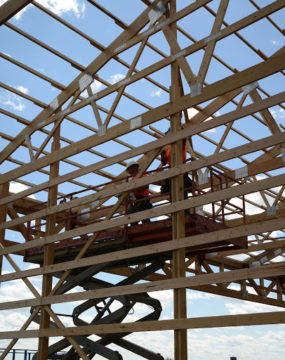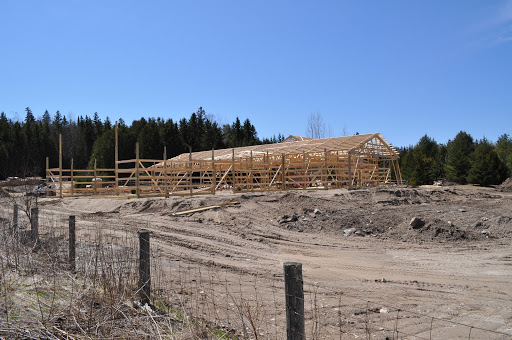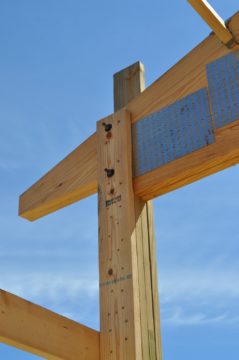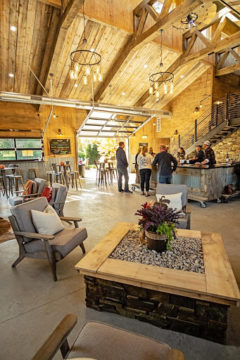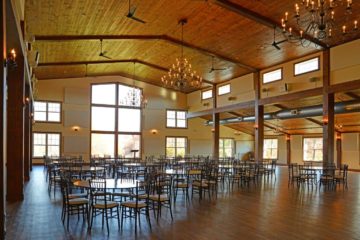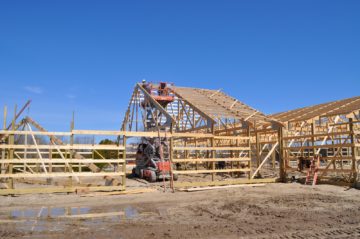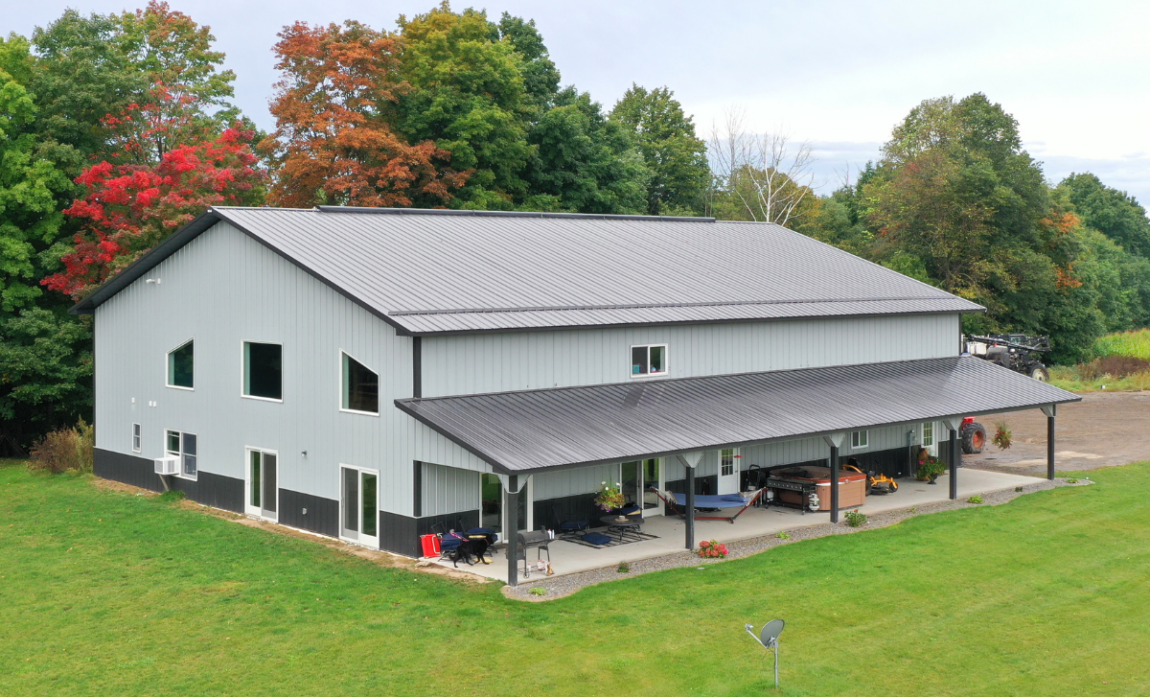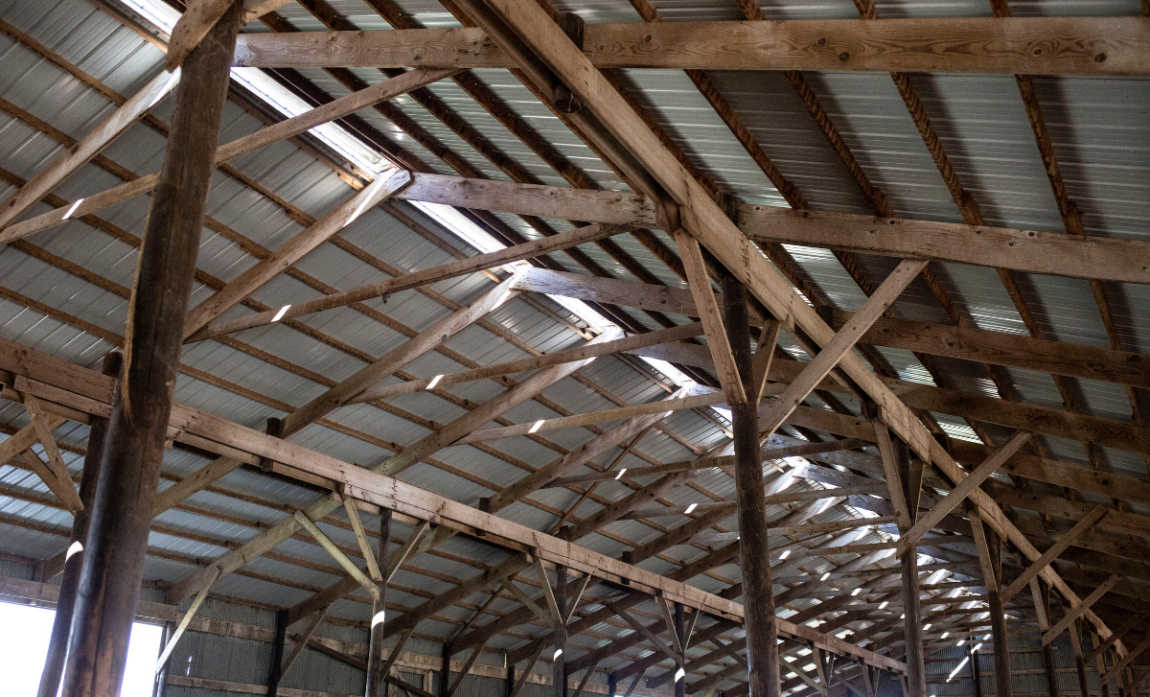It can be easy to confuse rafters with trusses. Although both types of components are used to support the roof of a building, they’re different in fundamental ways. We’ll dive deep into a rafters vs. trusses comparison below. But we’ll do more than that.
We’ll help you understand why roof trusses are by far the smarter choice for most construction projects, especially for post-frame buildings (commonly known as pole barns). These are made with highly engineered laminated wooden posts and prefabricated trusses, which help transfer wind and snow loads to the foundation.
Post-frame buildings typically have expansive, unobstructed interior spaces. They’re also extremely economical, with a wide range of potential uses. Roof trusses play a big role in that. View this short overview video, and then we’ll take a closer look at why.
Rafters and Trusses 101
First, let’s cover the basics. Rafters and trusses are both:
- Used to support the roof of a building
- Typically made of wood materials
- Triangular in their basic shape
And that’s pretty much where the similarities end.
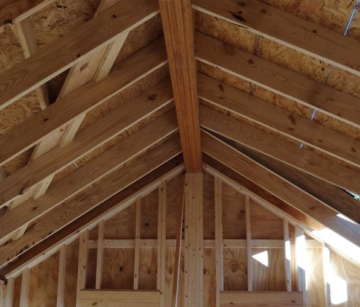 Roof rafters in a smaller structure (Source)
Roof rafters in a smaller structure (Source)
Rafters
Roof rafters like those shown above were more commonly used in home construction in the past. For example, if your house was built before the 1960s, there’s a good chance it has rafters rather than trusses.
For smaller building projects, especially those that don’t require a wide span, rafters can still be a convenient option. They’re made up of angled boards that connect the ceiling’s peak—sometimes called the ridge board—to the top of the exterior walls.
The individual components are typically measured, cut, and assembled on site.
Trusses being installed for a post-frame building
Trusses
Modern roof trusses were invented in the 1950s. Since then, they have become the most popular form of roof support, largely because they’re more cost-effective and structurally superior for most buildings.
In fact, about 3 out of 4 residential home builders today report using prefabricated roof trusses. And when it comes to post-frame builders, that number is even higher.
The basic components that help roof trusses perform so well include two top chords, a bottom chord (or beam), and web pieces, along with metal connectors, or nail plates.
Trusses are prefabricated in a factory and brought to the project site ready to install.
Let’s get into more detail on the advantages of trusses.
1. Trusses have better physics behind them
Because of the way trusses are structured, you gain more rigidity and have less potential deflection, or bending, than with rafters.
For example, let’s say you have a rafter beam spanning 15 feet at an incline. It doesn’t have a lot bracing it other than its own stiffness (and its ability to bend). But that same span configured as a truss will also have multiple members bracing it along that length, which results in more stability.
Now think of the entire truss, which is like a web-like structure comprising various sizes of wood components linked with metal connector plates. That design generates exceptional strength, and it does so using less material than rafters.
2. Trusses reduce time, labor, material, AND costs
Let’s turn from physics to finances. You might think the superior performance of roof trusses naturally means higher costs. But for reasons like the following, that’s usually not the case.
Sure, for fairly small sheds and other structures, rafters can work fine. But just how big is the structure you have in mind? Measuring and cutting lumber—on the project site—to meet exacting specifications is no picnic.
It takes both lots of time and skill, which can mean more days, weeks, or longer, especially when delays arise due to weather, worker injury, or other unwanted events. And that equates to more money.
Trusses not only require less building materials; they arrive at the project site prefabricated and ready to put in place. That means they can go up one after the other, lickety-split, in a matter of days, which can be a huge cost-saving factor.
3. Trusses mean superior quality and accuracy
Don’t underestimate the fact that roof trusses are prefabricated in an exacting, climate-controlled factory environment. This helps produce consistently high-quality components with near-perfect accuracy for meeting building specs.
Rafters, on the other hand, are built piece by piece on site. Their accuracy depends on the skill of the workers. Moreover, because this is a very time-consuming process, projects take longer, which also increases the chances of lumber sitting exposed to the elements, thereby degrading the quality.
Exposed roof trusses at Boyne Valley Winery
4. Trusses create more space at less expense
When used in larger buildings, rafters will need the support of load-bearing interior walls. But the design of trusses allows them to span longer distances without direct support underneath them.
That’s why trusses work especially well for buildings like event centers, equestrian buildings, or large implement storage sheds. Plus, the absence of load-bearing walls makes it easy for the interior of a building to be modified for different uses.
Now you’re not just saving on the overall lower costs of trusses vs. rafters; you’re saving on the labor and materials for walls you don’t necessarily want or need.
5. Trusses make dramatic ceilings more feasible
Closely related to No. 4 is the question of the ceiling above all that open area. Trusses make it much more cost-effective to build expansive, visually stunning ceilings.
Note that you may be slightly more limited in the pitch of your ceiling compared to the pitch that rafters will allow. But that’s hardly a huge sacrifice when you consider all the advantages you’re getting from the trusses.
And then there are the results. Take a look at the truss ceiling in the event center above. How’s that for dramatic? (Check out this page for more details on the project.)
What about attic space?
It’s possible that you may not want an expansive ceiling space. Maybe instead you want a spacious attic. That’s actually one common argument for rafters.
However, if having a rec room, hobby room, or extra bedroom in the attic is indeed one of your project goals, you should know that trusses don’t necessarily eliminate that possibility. For example, Wick has a special line of products called attic trusses that enable customers to achieve the kind of attic space they want.
And if you’re looking to just store your extra stuff or seasonal items out of view, Wick also offers Bonus Storage Trusses. These engineered trusses use a beefed-up design and allow for a floor to be installed that can support 40 lbs/square foot.
Moreover, Bonus Storage Trusses can meet your needs at a much lower cost—typically around 50% less—than increasing the size of the building.
For more information, check out Mega-Room: Increase Your Space Without Building A Bigger Storage Shed.
6. Trusses demand careful planning (and that’s a good thing)
For smaller sheds and similar projects, you could in theory do some basic measurements, head to your local lumber yard, and return home to start building your rafters right away.
But if you’re looking to build a sound structure that will last decades and keep animals, inventory, equipment, and/or people safe, you’re going to want to plan extra-carefully.
No question about it: Trusses demand lead time because you want to be sure about what you’re ordering. But that’s hardly different than any other custom building component.
And just how in a hurry are you? At Wick Buildings, it’s possible to fabricate your trusses on Monday and have them show up at your project site by Wednesday or Thursday.
Special note on access and equipment
The fact that trusses arrive at the project site ready to go is a huge benefit that saves time, labor, and, ultimately, dollars. But just to be clear, prefabricated trusses can be fairly large.
For a typical post-frame building project, the trusses will need to be transported by semi to the project site and put into place with the help of a lift or a crane.
Now, even with those factors, trusses still end up being less costly than all the lumber and labor it would take to construct rafters.
Your project site will, however, need to be accessible for the trusses to be hauled in and put in place. That could be a problem in extremely rural areas or tight urban spaces. If you have any questions related to your project site’s accessibility, a qualified post-frame builder can help. More on that below.
Beyond Trusses: The Benefits of a Post-Frame Building
Rafters have their place, especially for small building projects. But prefabricated roof trusses have revolutionized the building process because they work exceptionally well for a variety of structures—and are extremely cost-effective.
That’s especially true for post-frame buildings, or pole barns. Now that you have a glimpse of why trusses work so well in these, you may want more information on post-frame buildings themselves.
For starters, check out What Is a Pole Barn? The Difference Between a Pole Building vs. Stick Frame.
Thinking about a pole barn project of your own? Keep in mind that these aren’t simple projects. The right design, the appropriate materials, and smart construction practices are essential for a functional, cost-efficient, and durable post-frame building you can enjoy for years to come.
But you don’t have to go it alone. If you’d like to talk with an expert, be sure to click on the Find Your Builder link, and we’ll align you with a post-frame builder in your area.

